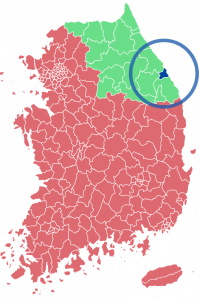
Donghae City
Donghae City (동해시; map) is a coastal municipality on the southeastern part of Gangwon State seated between the Taebaek Mountains and the vast expanse of the East Sea. This unique positioning offers a combination of rugged mountain terrains and coastal views.
Historically, Donghae’s development has been closely tied to its geographical location. Its economy centers on resource extraction from its mineral-rich mountains, and fishing and shipping industries. However, the city is shifting towards tourism. Its natural attractions, like Mureung Valley and Chuam Candlestick Rock, draw visitors from across the country and beyond.
Donghae City is also notable for its cultural heritage. It hosts several local festivals and events that celebrate its maritime and mountain culture. Visitors can enjoy a range of activities, from relaxing on the beach to explore historical temples and trekking in the Taebaek Mountains.
Coastal Donghae
Coastal Donghae contains a blend of natural splendor and a rich maritime legacy. Spanning 50 kilometers along the East Sea, and offering sandy beaches, cliffs, and hidden coves, this picturesque shoreline is not only a magnet for tourists but also a vital part of Donghae’s economy, but contains a few ports that act as an anchor for fishing, commerce, and cultural.
Donghae Ports
Here is a list of major ports in Donghae City that stand as the city’s lifelines for the maritime world.
- Donghae Port (동해항; map) is a crucial trade hub. It holds South Korean Navy’s 1st Fleet and the Army’s 23rd Guard Brigade. Opened in 1979 as an artificial harbor, Donghae Port primarily manages the handling of cement, bituminous coal, and limestone, cementing its role in facilitating significant trade and logistics activities in Northeast Asia.
- Mukho Port (묵호항; map) serves as a hub for coal shipping, fishing, since 1937. Known for its deep waters and fishing spots, the port is next to a fish market famous for fresh sashimi. Key facilities include the Mukho Port Passenger Terminal, Mukho Lighthouse, Dojebigol Sky Valley, and Nongoldam Street.
Food
Donghae City, in South Korea, offers a rich culinary experience. Here are some of the key dishes to sample when visiting:
- Bukpyeong Folk Market‘s (북평민속시장; map) Jangteo Gukbap (장터국밥):
- In Bukpyeong Folk Market, Jangteo Gukbap is a traditional Korean soup. Known for its rich broth made from simmering beef bones.
- Enjoy it with various toppings like beef head meat, pork, blood sausage, and intestines.
- Other unique local specialties include gomchi soup (곰치국), buckwheat pancakes or jeon (메밀전), various traditional Korean rice cakes (떡), and trendy shrimp dumplings (새우만두; mandu).
- Mukho Port’s (묵호항; map) Red Shrimp Dishes (홍새우 요리):
- Mukho Port is famous for its fresh and diverse seafood.
- Red shrimp, known for their sweet taste and soft shells, are a local specialty.
- The shrimp are often marinated in soy sauce and chili powder.
- Jangkalguksu (장칼국수) at Donghae Central Market (동쪽바다 중앙시장; map):
- This hearty noodle soup, a comfort food perfect for cold weather.
- Made with hand-pulled dough, shrimp, and anchovy broth, offering a unique and spicy taste.
- Donghae’s Fresh Seafood:
- Local Cuisine in Mureung Valley (무릉계곡; map):
- Mureung Valley (무릉계곡) is home to many local restaurants.
- Must-try dishes include savory potato pancakes, mountain vegetable bibimbap, and flavorful hwanggi chicken soup (황기백숙).
Ten Scenic Sights of Donghae
Donghae City sports a cornucopia of natural beauty and cultural heritage. Here are some of the must-visit scenic sights in Donghae:
- Chuam Candlestick Rock (추암촛대바위; map): Famed for its stunning natural scenery, the rock formation sits near Chuam Beach in the south end of Donghae City. It is famous as a backdrop for the first stanza of the national anthem.
- Cheongok Golden Bat Cave (천곡황금박쥐동굴; map): A 1,510-meter-long limestone cave estimated to be 4-5 billion years old, in the city center. It’s known for its unique stalactites and stalagmites and serves as a natural educational site.
- Nongoldam Street (논골담길; map): A village with emotional stories of Mukho Port, featuring murals created by local elders and artists. Each alley has different themes, showcasing the city’s history and culture.
- Mureung Valley (무릉계곡; map): A scenic spot with many peculiar rock formations. It’s known as a heavenly place with a backdrop of Dutasan and Cheongok Mountains. The area is filled with various natural and historical attractions.
- Yongchu Waterfall (용추폭포; map) and Ssang Waterfall (쌍폭포; map): In Mureung Valley, these waterfalls are known for their unique shapes and the clarity of their waters, resembling a dragon ascending to the heavens.
- Mukho Port (묵호항; map) and Mukho Lighthouse (묵호등대; map): A major coal transport hub since 1936, the port has become a lively fish market with fresh seafood. The lighthouse, a popular tourist attraction, offers stunning views of the East Sea and has been featured in various films.
- Bukpyeong Folk 5-Day Market (북평민속 5일장; map) and Mukho Night Market (묵호 야시장; map): The 200-year-old market offers local delicacies and products. The night market, popular among tourists, features performances and diverse food options.
- Gamchusa Temple (감추사; map) & Gamchu Beach (감추해변; map): Near downtown Donghae, the beach is a quiet spot perfect for family outings and fishing, with a temple steeped in legends of Princess Sunhwa of the Silla Dynasty.
- Dokjaebi Valley Sky Valley (도째비골 스카이밸리; map): This tourist spot near Mukho Lighthouse offers panoramic views of the East Sea and thrilling experiences like a skywalk, sky cycle, and giant slide, making it an ideal destination for adventure seekers.
- Mangsang Beach (망상해수욕장; map): Known for its shallow waters, clean sea, and sandy beaches, it’s a popular destination visited by millions each year. The adjacent auto camping resort offers a nature-friendly leisure space with various accommodations.
Inland Donghae
The Taebaek Mountain Range dominates Donghae City’s inland regions. They present a rugged yet serene landscape. The range’s dense forests and rolling hills offer a stark contrast to Donghae’s bustling coastal regions.
Mureung Valley (무릉계곡; map) may be the most visited among the picturesque valleys. Framed by the Dutasan and Cheongoksan mountains, its renowned for its lush forests and striking rock formations, waterfalls, serene ponds, and historical sites like Samhwa Temple (삼화사; map). Each season brings a distinct character, from vibrant spring greens to rich autumn hues.
Donghae’s inland is also home to traditional villages, preserving the region’s rich cultural heritage. Some examples include:
- Samhwa-dong (삼화동; map): Known for its picturesque landscapes and historical significance, Samhwa-dong is near Mureung Valley. The village offers a glimpse into traditional Korean rural life, with well-preserved homes and community structures.
- Cheongok-dong (천곡동; map): This village is notable for its proximity to the Cheongok Golden Bat Cave (천곡황금박쥐동굴; map), blending natural wonders with cultural heritage. It’s a great place to experience a traditional Korean lifestyle alongside unique geological features.
Inland Donghae’s diverse topography provides a haven for outdoor enthusiasts, including hikers and nature lovers. The area’s trails cater to a wide range of preferences, from casual walks to more challenging hikes.
- Dutasan Mountain (두타산; map): Known for its lush forests and panoramic views, the Dutasan Trail is moderately challenging and leads to panoramic viewpoints where you can view mountainous terrain and dense woodlands.
- Deokhangsan Mountain (덕항산; map): This lesser-known mountain offers a peaceful hiking experience. The Deokhangsan Trail is suitable for families and beginners. It meanders through vibrant greenery and occasional clearings, offering views of the surrounding countryside.
- Mureung Valley (무릉계곡; map): Nestled between Dutasan and Cheongoksan, Mureung Valley is a geological marvel. The trail features a leisurely walk, ideal for enjoying the serene streams, diverse flora, and the famous rock formations.
- Cheongoksan Mountain (청옥산; map): It boasts trails that range from moderate to difficult. The paths ascend through dense forests, opening up to views of the East Sea and Donghae’s rugged landscape.
- Bukpyeong Trail (북평길; map): Perfect for those interested in combining cultural exploration with hiking. This trail passes through the historic Bukpyeong Market, leading up into the hills where one can experience both the urban and natural.




